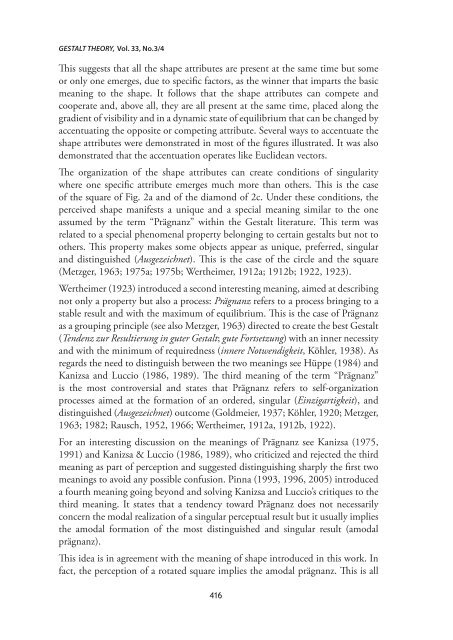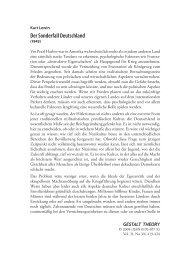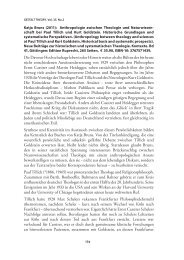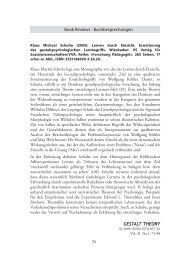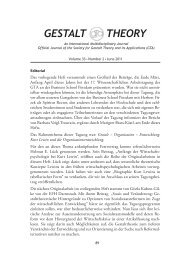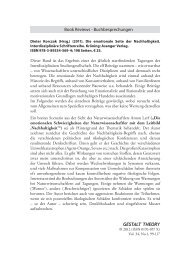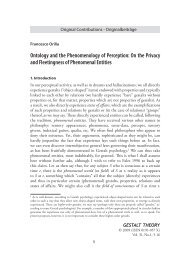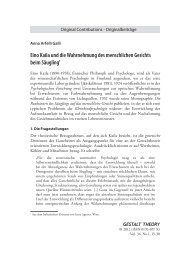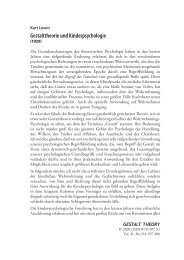What is the Meaning of Shape? - Gestalt Theory
What is the Meaning of Shape? - Gestalt Theory
What is the Meaning of Shape? - Gestalt Theory
Create successful ePaper yourself
Turn your PDF publications into a flip-book with our unique Google optimized e-Paper software.
GESTALT THEORY, Vol. 33, No.3/4<br />
Th<strong>is</strong> suggests that all <strong>the</strong> shape attributes are present at <strong>the</strong> same time but some<br />
or only one emerges, due to specific factors, as <strong>the</strong> winner that imparts <strong>the</strong> basic<br />
meaning to <strong>the</strong> shape. It follows that <strong>the</strong> shape attributes can compete and<br />
cooperate and, above all, <strong>the</strong>y are all present at <strong>the</strong> same time, placed along <strong>the</strong><br />
gradient <strong>of</strong> v<strong>is</strong>ibility and in a dynamic state <strong>of</strong> equilibrium that can be changed by<br />
accentuating <strong>the</strong> opposite or competing attribute. Several ways to accentuate <strong>the</strong><br />
shape attributes were demonstrated in most <strong>of</strong> <strong>the</strong> figures illustrated. It was also<br />
demonstrated that <strong>the</strong> accentuation operates like Euclidean vectors.<br />
The organization <strong>of</strong> <strong>the</strong> shape attributes can create conditions <strong>of</strong> singularity<br />
where one specific attribute emerges much more than o<strong>the</strong>rs. Th<strong>is</strong> <strong>is</strong> <strong>the</strong> case<br />
<strong>of</strong> <strong>the</strong> square <strong>of</strong> Fig. 2a and <strong>of</strong> <strong>the</strong> diamond <strong>of</strong> 2c. Under <strong>the</strong>se conditions, <strong>the</strong><br />
perceived shape manifests a unique and a special meaning similar to <strong>the</strong> one<br />
assumed by <strong>the</strong> term “Prägnanz” within <strong>the</strong> <strong>Gestalt</strong> literature. Th<strong>is</strong> term was<br />
related to a special phenomenal property belonging to certain gestalts but not to<br />
o<strong>the</strong>rs. Th<strong>is</strong> property makes some objects appear as unique, preferred, singular<br />
and d<strong>is</strong>tingu<strong>is</strong>hed (Ausgezeichnet). Th<strong>is</strong> <strong>is</strong> <strong>the</strong> case <strong>of</strong> <strong>the</strong> circle and <strong>the</strong> square<br />
(Metzger, 1963; 1975a; 1975b; Wer<strong>the</strong>imer, 1912a; 1912b; 1922, 1923).<br />
Wer<strong>the</strong>imer (1923) introduced a second interesting meaning, aimed at describing<br />
not only a property but also a process: Prägnanz refers to a process bringing to a<br />
stable result and with <strong>the</strong> maximum <strong>of</strong> equilibrium. Th<strong>is</strong> <strong>is</strong> <strong>the</strong> case <strong>of</strong> Prägnanz<br />
as a grouping principle (see also Metzger, 1963) directed to create <strong>the</strong> best <strong>Gestalt</strong><br />
(Tendenz zur Resultierung in guter <strong>Gestalt</strong>; gute Fortsetzung) with an inner necessity<br />
and with <strong>the</strong> minimum <strong>of</strong> requiredness (innere Notwendigkeit, Köhler, 1938). As<br />
regards <strong>the</strong> need to d<strong>is</strong>tingu<strong>is</strong>h between <strong>the</strong> two meanings see Hüppe (1984) and<br />
Kanizsa and Luccio (1986, 1989). The third meaning <strong>of</strong> <strong>the</strong> term “Prägnanz”<br />
<strong>is</strong> <strong>the</strong> most controversial and states that Prägnanz refers to self-organization<br />
processes aimed at <strong>the</strong> formation <strong>of</strong> an ordered, singular (Einzigartigkeit), and<br />
d<strong>is</strong>tingu<strong>is</strong>hed (Ausgezeichnet) outcome (Goldmeier, 1937; Köhler, 1920; Metzger,<br />
1963; 1982; Rausch, 1952, 1966; Wer<strong>the</strong>imer, 1912a, 1912b, 1922).<br />
For an interesting d<strong>is</strong>cussion on <strong>the</strong> meanings <strong>of</strong> Prägnanz see Kanizsa (1975,<br />
1991) and Kanizsa & Luccio (1986, 1989), who criticized and rejected <strong>the</strong> third<br />
meaning as part <strong>of</strong> perception and suggested d<strong>is</strong>tingu<strong>is</strong>hing sharply <strong>the</strong> first two<br />
meanings to avoid any possible confusion. Pinna (1993, 1996, 2005) introduced<br />
a fourth meaning going beyond and solving Kanizsa and Luccio’s critiques to <strong>the</strong><br />
third meaning. It states that a tendency toward Prägnanz does not necessarily<br />
concern <strong>the</strong> modal realization <strong>of</strong> a singular perceptual result but it usually implies<br />
<strong>the</strong> amodal formation <strong>of</strong> <strong>the</strong> most d<strong>is</strong>tingu<strong>is</strong>hed and singular result (amodal<br />
prägnanz).<br />
Th<strong>is</strong> idea <strong>is</strong> in agreement with <strong>the</strong> meaning <strong>of</strong> shape introduced in th<strong>is</strong> work. In<br />
fact, <strong>the</strong> perception <strong>of</strong> a rotated square implies <strong>the</strong> amodal prägnanz. Th<strong>is</strong> <strong>is</strong> all<br />
416


